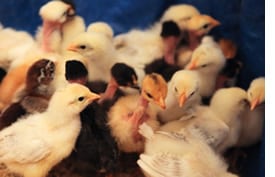 My family has been raising a small backyard chicken flock for about seven years now, and we have had our ups and downs during this time. From learning about predation and having to protect against it, to dealing with frozen chicken waterers in the winter, to lack of eggs from molting and light conditions, raising chickens is always an adventure. Through this adventure we have increased our awareness of where our food comes from and what it means to have quality meat. So this winter we decided to take the next step and move from a small backyard flock of six birds to raising all of our own meat birds for processing this spring and summer.
My family has been raising a small backyard chicken flock for about seven years now, and we have had our ups and downs during this time. From learning about predation and having to protect against it, to dealing with frozen chicken waterers in the winter, to lack of eggs from molting and light conditions, raising chickens is always an adventure. Through this adventure we have increased our awareness of where our food comes from and what it means to have quality meat. So this winter we decided to take the next step and move from a small backyard flock of six birds to raising all of our own meat birds for processing this spring and summer.
(If you are just starting off with chickens or are thinking setting up your own backyard flock, please read the article Raising Your Own Chickens as a starting point.)
This new adventure has provided me a whole new knowledge set, and I would like to share just a few of the new insights I have learned over the last few months.
- US Postal Service Is Amazing
We ordered our first set of meat birds online through McMurray Hatchery and got a mix of 25 heritage breed chicks. We were a little unsure about having birds shipped in the mail, as we are a bit remote in Northern California and the chickens were coming from Minneapolis during the first part of February. Would they survive? Having always purchased chicks from our local feed store, we did not know what to expect. Turns out to be a flawless system.
The chicks where shipped on a Saturday, we got a automated call from the hatchery on Sunday that they were arriving on Monday morning, and the post office called at 7:30 am Monday morning to say they had arrived. All 27 arrived safely and alive (2 free extras brought our numbers up), and the box was much smaller than expected. It is really an amazing service that moves our letters and packages of all kinds around for so little money. USPS will be greatly missed as things change for them over time.
- Vaccination vs. Medicated Feed
When we ordered our chicks from the hatchery, we had the option of choosing to have the chicks vaccinated against coccidia. Coccidia is a disease caused by an internal parasite. The parasites are prevalent in most areas, and can cause bloody poop, dehydration, and death in your flock. With Coccidia you have two management choices: Either get the vaccine at 1-3 days of age, or use medicated feed. We try to avoid medicated feed whenever possible, so we opted for the vaccine. The vaccine is also compliant with USDA organic standards, while medicated feed is not. Coccidia can also be prevented by keeping your chicks area clean and dry, and not overcrowding your flock. We do live in an area of Northern California that can get quite a bit of spring rain, which can make outdoor conditions ideal for coccidia to expand to unhealthy levels.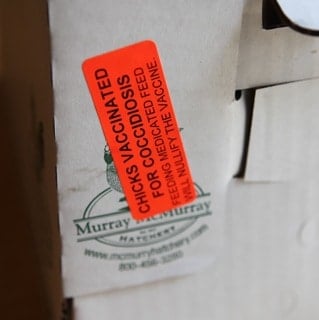
- Heritage vs. Hybrids
Once we decided to try our hand at raising our own meat birds, one of the first things we had to decide was which breeds to raise. We did a lot of research and ultimately decided to go with two breeds of Heritage Chickens: Delaware and Turkens (aka Naked Necks). The breeds raised by industry for meat chickens are a hybrid bird, with such an extreme rate of growth that problems can and do arise. After talking to other local homesteaders, we heard stories of chickens growing so fast they could no longer walk. Their legs would break from the enormous amount of weight they were carrying around, and many died because they couldn't walk to find water or food. We heard stories of "emergency processing" having to be done because of breasts splitting open due to such rapid growth. And since these breeds are hybrids, they cannot be bred to continue future generations. They grow so fast that by the time they are of sexually maturity, they cannot breed successfully anyway. We were looking for dual-purpose breeds that were good foragers, could potentially breed so we could sustainably keep a flock going, had the potential to become broody (the characteristic of a female bird sitting on her owns eggs and hatching them), and all while still producing a decent size meat bird. And let's not forget about taste! If you have never tasted a heritage breed of chicken, you are missing out.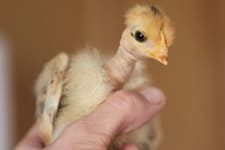
- Pasty Bottoms
Another new issue we had to deal with is poopy bird butts. Baby chicks can develop dried and blocked bottoms from lack of water and confined transport when being shipped, so you needs to monitor this and remove any build up as it occurs. If it becomes too much of an issue it can cause slow initial growth and possibly death. The dried excess can be removed with a warm damp towel. There is nothing quite like spending a Friday night cleaning chicken bottoms. Let's just say that I am far more resilient now.
- Water Precautions
Keeping your chicks warm and dry at the initial stages of life is important. With the new watering container we purchased for this new set of chickens came instructions and warnings of baby chicks getting wet and getting sick from the water exposure. Until their down (fuzz) is replaced by feathers, it is recommended that you place pebbles or rocks in the bottom of the water tray to help keep them out of it and stay dry. We did take this step, and it worked as intended. The only issue is that is does make cleaning the waterer a bit more difficult. You only have to do this for the first 2-3 weeks.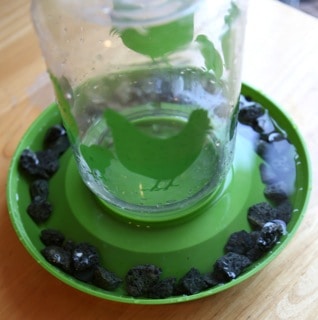
- Space Issues
When we first started raising chickens seven years ago, we started off with four little chicks -- tiny cute balls of fluff. The size of the brooder was not a big issue with only four chickens, since most containers could handle their size and growth. A bathtub would even work. I was originally thinking that I could use the guest bathtub for the 25 new arrivals. Then after doing some calculations and measurements, I realized I needed a bigger space. Much bigger!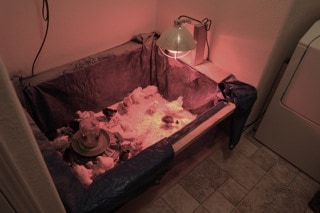
The recommended minimum space for new chicks is a 1/2 sq ft per bird for the first 2 weeks. Then it goes up to 3/4 sq ft per bird after the first 2 weeks. So our first problem was to find a space indoors that could accommodate 12 sq ft of brooder space until we could build an outdoor space larger enough and warm enough to move them after the first 2 weeks. Some 2x4s and a tarp did the trick for a temporary brooder. The next challenge is build a secure outdoor mobile brooder large enough for the long haul that allows for pasture access. We will be building a mobile cattle panel chicken tractor with brooder area as our first setup. Raising livestock is always an adventure.
So I hope these lessons learned from my experiences help give you some insight and additional foundational knowledge to raising larger numbers of birds or expanding a flock. Additional articles will be coming soon on other CM.com members' experiences with raising large flocks and processing chickens for consumption. I invite you to share your experiences and thoughts in the comments section below and look forward to sharing more updates as our little project progresses.
- Jason
This is a companion discussion topic for the original entry at https://peakprosperity.com/six-lessons-from-an-expanding-flock-2/